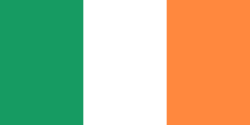Commissioners of Irish Lights
| Commissioners of Irish Lights — CIL — | |
|---|---|
 | |
| Bestehen | seit 1867 |
| Hauptsitz | Dún Laoghaire |
| Koordinaten | 53° 17′ 48,2″ N, 6° 8′ 20,7″ W |
| Behördenleitung | Sheila Tyrrell (Chairman)[1] |
| Website | www.irishlights.ie |
Die Behörde Commissioners of Irish Lights (CIL) (deutsch Beauftragte für irische Leuchtfeuer, irisch Coimisinéirí Soilse na hÉireann) ist zuständig für die Leuchttürme und Schifffahrtszeichen in Irland und Nordirland sowie den vorgelagerten Inseln und angrenzenden Gewässern.
Das Hauptquartier liegt am Hafen von Dún Laoghaire, südlich von Dublin.
Allgemeines
Die Commissioners of Irish Lights ist neben Trinity House und Northern Lighthouse Board die dritte Behörde (englisch General Lighthouse Authority) für Leuchttürme und Schifffahrtszeichen auf den britischen Inseln. Sie beaufsichtigt auch die Leuchtfeuer und Navigationshilfen lokaler Hafenbehörden.
Finanziert wird die Arbeit aus dem allgemeinen Leuchtturm-Etat (General Lighthouse Fund), der vom britischen Verkehrsministerium (Department for Transport) verwaltet wird. Die Einnahmen stammen aus Hafengebühren und einem jährlichen Zuschuss der irischen Regierung.

Die automatisierten Leuchttürme werden vom Hauptquartier in Dún Laoghaire überwacht. Für Wartungs- und Reparaturarbeiten wird das Personal überwiegend von Hubschraubern zu den Stationen gebracht. Als einziger Tonnenleger ist seit 2000 die Granuaile im Einsatz.
Leuchttürme
Weblinks
Einzelnachweise
- ↑ Organisation and Board. CIL, abgerufen am 13. März 2014 (englisch).
Auf dieser Seite verwendete Medien
Man sagt, dass der grüne Teil die Mehrheit der katholischen Einwohner des Landes repräsentiert, der orange Teil die Minderheit der protestantischen, und die weiße Mitte den Frieden und die Harmonie zwischen beiden.
Autor/Urheber: Paul O'Donnell, Lizenz: CC BY 2.0
Bailey Lighthouse on Howth Head - Helicopter Approach
Autor/Urheber: William Murphy from Dublin, Ireland, Lizenz: CC BY-SA 2.0
A Brief History of Irish Lights
The oldest operational lighthouse in Ireland and the British Isles is at Hook Head. The tower, with additions and modifications, dates from the Norman times, 12th century, and is reputed to be built on the site where the monks of St. Dubhan established a fire beacon in the 5th century.
Another Norman lighthouse at Youghal was in the hands of local sisters attached to St Anne's Convent, but the tower fell out of use around Cromwell's time and was replaced by the present tower in 1852.
The Commissioners of Irish Lights are the statutory Lighthouse Authority for all of Ireland. Originally lighthouses were in private hands and in 1665 King Charles II granted letters patent to Sir Robert Reading to erect six lighthouses on the coast of Ireland, two of which were placed on Howth, one to mark the land, the other to lead over the bar; the others were at Old Head of Kinsale, Barry Oge's castle (now Charlesfort, near Kinsale), Hook Head and Isle of Magee, near Carrickfergus. Of these six lights, two were short lived - the Howth bar light and Isle of Magee. The latter was re-established later on the Lesser Copeland Island. All these lights had a coal fire on each of their roofs.
These lighthouses were transferred to certain commissioners set up by Queen Anne in 1704. (These commissioners were not the present Commissioners of Irish Lights.) In 1717, during the reign of George I, the lands on which barracks and lighthouses were built were vested in the Crown at a price ascertained by special commissioners. These powers were transferred to the Commissioners for Barracks in 1767.
In 1708, Dublin Corporation, through Parliament, set up a Committee known as the Ballast Committee. In 1786 an act of the Irish Parliament replaced the Ballast Committee with a new ?body corporate and politik?, independent of Dublin Corporation, called the Corporation for Preserving and Improving the Port of Dublin (also known as the Ballast Board). The constitution of this Board is that of the present Commissioners of Irish Lights.
HM Revenue Commissioners were given power in 1796 to erect lighthouses on the coasts of Wexford, Mayo, and Galway. Further acts between 1800 and 1806 were passed in connection with lighthouses, dues, and purchasing land for lighthouses. In 1810 powers given to the Commissioners for Barracks and others between 1767 and 1806 were all vested in the Corporation for Preserving and Improving the Port of Dublin or the Ballast Board.
This Board took over the general lighting and marking of the coast when fourteen lighthouses were transferred to it - South Rock, Old Head, Wicklow (2), Howth, Copeland, Hook, Cranfield, Loophead, Aranmore, Clare Island, Balbriggan, Duncannon Fort, and Charlesfort.
The Merchant Shipping Act of 1854 divided the Corporation or Ballast Board into two distinct corporate bodies, identical in personnel and constitution, namely the Corporation for Preserving and Improving the Port of Dublin for Dublin port, and the Port of Dublin Corporation for lighthouses, lightships, buoys, and beacons around the coast of Ireland.
The severance begun in 1854 was completed by the Dublin Port Act of 1867, the Corporation for Preserving and Improving the Port of Dublin became the Dublin Port and Docks Board and the Port of Dublin Corporation became the Commissioners of Irish Lights.
Originally, the number of Commissioners was twenty two, but when the position of High Sheriff of Dublin was abolished, the number was reduced to twenty-one. In 1996 it was further reduced to sixteen, viz the Lord Mayor of Dublin, three members of Dublin Corporation, elected annually by the Corporation and twelve co-opted members.
On 2 December 1999 the Irish and UK Governments signed orders establishing the six Implementation Bodies agreed in the Belfast Agreement. One of these is the Foyle, Carlingford and Irish Lights Commission. Primary legislation is required in both Westminster and Dublin to enable the functions of the Commissioners of Irish Lights to be incorporated into the new body. In the meantime the Commissioners of Irish Lights continue to operate under existing Irish and UK law.

